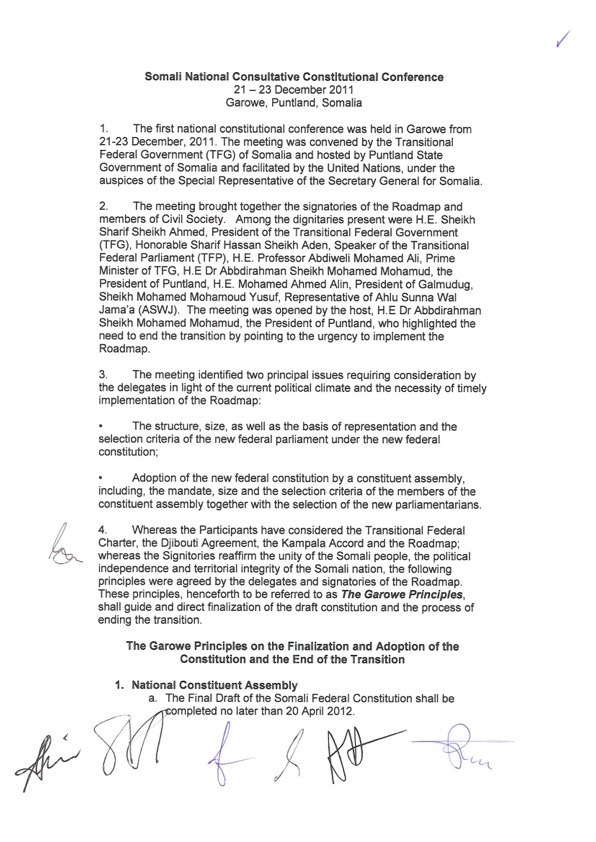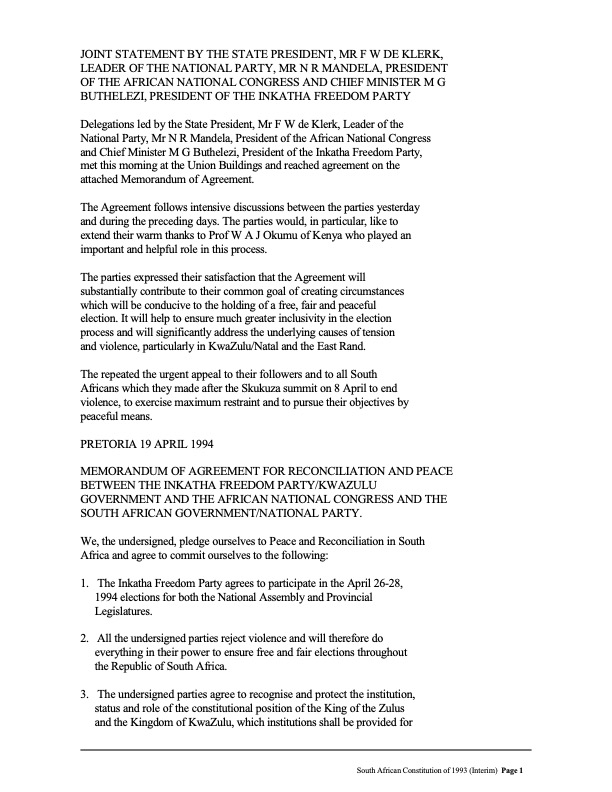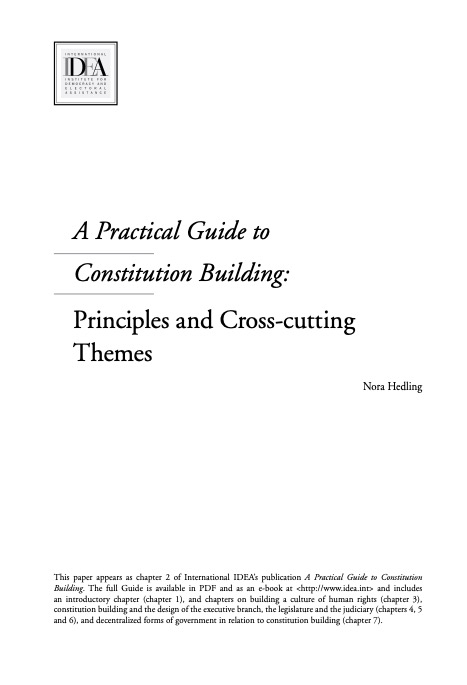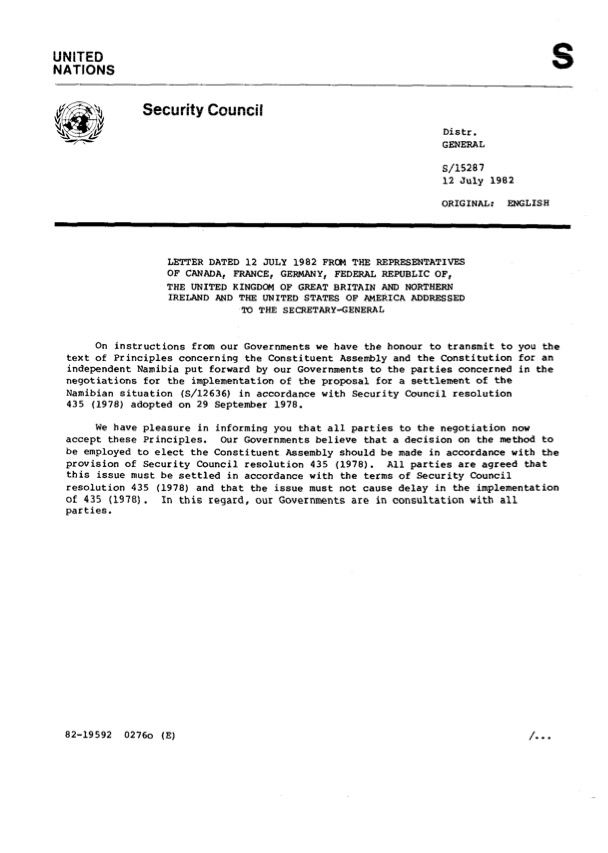The reports on this page provide guidance on the articulation and incorporation of moral, ethical, democratic and other norms and values in the form of constitutional principles. Additional materials on these and related topics such as the design, content and legal status of preambles can be found below.
Primer
This Primer on “Constitutional principles” (sometimes called “guiding principles”) provides an overview of documented principles or concepts that are intended to provide substantive and/or procedural guidance to a constitutional process.
Sample Materials

In 2011 and 2012, the UN brokered the Somali National Consultative Constitutional Conference to establish a framework for the end of the Transitional Federal Institutions (TFI) in August 2012. The first conference (December 2011) led to a set of agreements between the Transitional Federal Government (TFG) and various Somali stakeholders outlining a framework for the political transition in August 2012 to a permanent, representative government. The agreement was entitled the Garowe (I) Principles on the Finalization and Adoption of the Constitution and the End of the Transition. The Principles include: that the final draft of the federal constitution should be completed no later than April 20, 2012; the National Constituent Assembly (NCA) and its role of the in adopting the constitution; the role of the Committee of Experts (CoE); and the post-transition parliamentary structure. At the 2nd Somalia National Constitutional Conference in February 2012, the parties agreed to the the Garowe (II) Principles on Federalism, System of Government and Ending of the Transition Through Operationalizing Garowe I. The principles include: federalism; the electoral system; operationalizing the Garowe I Principles; and civic education and public consultation on the draft constitution. Also included is a fact sheet on the Garowe Principles from UNPOS.

This is the interim constitution which was drafted at the Multi-Party Negotiation Process between May-November 1993 and was formally enacted by Parliament and came into force on April 27, 1994.
Selected Materials
This presentation from the Université d’Aix-Marseille looks at the design, content and legal status of preambles and general principles contained in modern constitutions.
This is a brief paper concerning constitutional principles. The paper discusses the how constitutional principles may be used to reach agreements in the constitution-making process, and refers South Africa as an example. The paper then sets out the reasons in favour of including constitutional principles within constitutions, and breaks down the means of doing so as follows: constitutional principles in a preamble; constitutional principles as founding provisions; constitutional principles permeating a constitution; and directive principles. Finally the paper sets out the legal implications of constitutional principles, including, but not limited to their providing guidance to courts.

This paper appears as chapter 2 of International IDEA’s publication A Practical Guide to Constitution Building. It focuses on constitutional principles. The paper starts by setting out the role of constitutional principles as embodying values, creating agreement, and informing the meaning of the constitution. Next the paper addresses how to enshrine and enforce constitutional principles. It divides principles into directive and derived principles, the latter being unwritten and/or implied, and looks at the role of founding provisions and preambles in setting the state for constitutional principles. Finally, the paper looks at cross-cutting themes/principles and how various constitutions may address them. The themes discussed include: democratic governance, principles related to the rule of law, principles related to diversity, and principles related to gender, religion, and international law.
Through a qualitative analysis of the legal status of preambles in different common law and civil law countries, this article highlights a recent trend in comparative constitutional law: the growing use of preambles in constitutional adjudication and constitutional design. The article also explores the theory of preambles and their functions. The article also presents a typology for determining the legal status of preambles: a symbolic preamble, an interpretive preamble, and a substantive preamble. The articles discusses certain countries and the EU (Treaty of Lisbon).
Further Reading
This is a comprehensive guide to constitution-making and reform. The book identifies the tasks that need to be carried out, the procedures that can be used, and who can do them. It is intended for a wide audience and to be a guide for anyone who is engaged in a constitution-making process, or who is interested in improving constitution-making practice. It includes a discussion on the following topics: Emerging guiding principles, Impacts of Adherence to Guiding Principles, The Role of a Constitution Issues of Process Key Components and Issues of the Constitution-Making Process Tasks and Responsibilities in Constitution-Making Assessing the Impact of Constitution-Making Who Does What in the Process Starting the Process Public Participation Administering and Managing the Process and its Resources The Agenda of Constitutional Issues and Generating Ideas on the Issues Debating and Deciding the Issues The Constitutional Text: Coherence and Drafting Adopting and Implementing the Constitution Institutions with Multiple Roles Institutions that Develop Proposals about which Final Decisions are Made Elsewhere Administrative Management Bodies Specialist or Technical Input Institutions Referendums and Plebiscites Civil society and the media and Guidance for the International Community.
This paper takes a comprehensive look at the use of constitutional principles in the constitution-making process. Drawing from the South African example, the author explores, among other things, the process of developing these constitutional principles, the role they play in constitution-making with significant public participation, and the various enforcement mechanisms available to ensure these principles are effective and abided by. To illustrate these points, the author examines the following case studies: South Africa, Namibia, Burundi, Cambodia, and Eritrea. The constitutional principles from these countries are then compared from both a substantive and procedural aspect. Lastly, the report looks at constitutional amendments whose substance does not accord with the underlying constitution.

